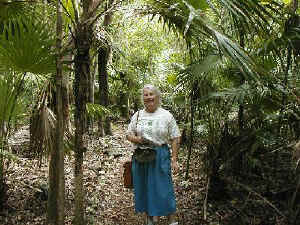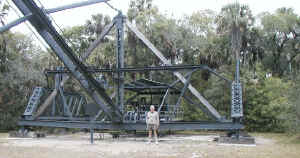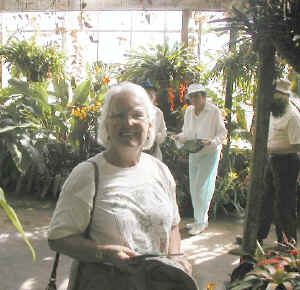|
The Everglades |
||
 |
We left at 7.15 Thursday morning, February 14, and visited the Blue Hole, at MM 30.5 on Pine Key, an old limestone quarry, now filled with fresh water. An alligator was in residence and roared for us, but we did not see any Key Deer. We saw four soft-shelled Florida turtles, and lots of fish, quite close to the alligator. We also met someone with a large German shepherd, which had recently had to swim fast to get to the shore ahead of the alligator. | |
| At Marathon, half way along the Keys (where the Tantons keep their boat) we visited Crane Point Hammock. (A hammock is an area of slightly higher ground with hardwood trees.) This has (another) wild bird rescue center, a Natural History Museum (iguanas, cockatoos, pond with koi, and arboretum). We walked along the Palm Trail and visited the Adderly House. Considering that the east coast and Key West were settled early, it was surprising to find that people homesteaded here in the late 19th and early 20th century, collecting sponges and taking them by boat to Key West to sell. Many of the settlers came from Bermuda. Everything changed when the railroad was completed in 1912. The weather was hot for walking (for Joyce). |  |
|
|
We gassed up in Key Largo, and it was slow going through Florida City and Homestead, until we turned west on Route 41 which crosses the Everglades as the Tamiami Trail (the Miami-Tampa road) and cuts through Big Cypress National Preserve.. The Big Cyprus visitor center has a good display on the endangered Florida Panther. DNA testing has shown that the few remaining animals are very interbred, so they imported six female cougars from Texas. The panthers have a high accident rate on the highway at night so the night speed limit is low. Also at the visitor center, we saw several alligators in the canal alongside the road. The canal resulted from the construction of the Tamiami Trail in the 1928, which disrupted the sheet drainage of the Everglades towards the south. Big Cypress is an uncomfortable mix of commercial (hunting, off road vehicles, oil and gas exploration, and cattle grazing) and environmental activities. The bald cypress trees (no leaves in winter) are not very tall, and the undergrowth is saw palmetto palm. The everglades to the south are more grassy and marshy. There are lots of ‘attractions’, many run by First Nations, offering airboat rides and alligator wrestling.
|
||
 |
Farther west along Route 41, we briefly visited Collier-Seminole State Park and saw a Walking Dredger used in the construction of the road, and for the first time encountered lots of mosquitoes. | |
|
The West Coast |
||
|
We reached the west coast near Marco Island and continued into Naples, where we drove around the old part of the city along 18th Ave then along Gulf Ave going north. This is an area of large, immaculate and very expensive houses. The hotels look expensive too. We cut back east to pick up I 75, and continued north to Venice and Sarasota. On the way we looked at the museum at Spanish Point, and drove along a sand spit called Casey Key to see the houses. |
||
|
Sarasota also appeared to be expensive. We spent a long time in the Marie Selby Botanical Gardens, where Joyce bought an orchid to bring home (very carefully).
|
 |
|
| Then we went back to I 75, and continued north to Port
Charlotte. We picked a motel out of a hotel ticket booklet, but they would not
meet the price.. The Harbor Motel was OK but old. However, we lucked out for
dinner. We went back across the bridge to Punta Gorda to Ray’s Celtic Pub.
Incredibly they had a Belgian Framboise on tap, for Joyce, and Peter had a draft
Fullers London Porter. As a follow up he had a Belgian Leffe. The Belgians were
served in the correct glasses too! The meals were cheap and good, fish and chips
for Joyce and a beef stew for Peter.
|
||